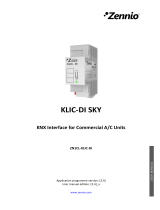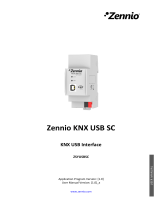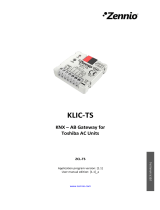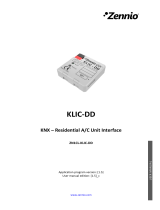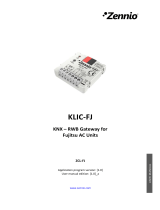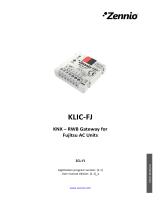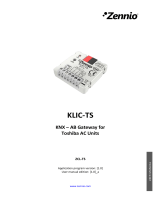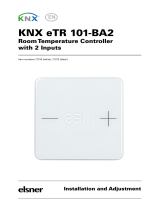Page is loading ...

KLIC-DI VRV
http://www.zennio.com Technical Support: http://support.zennio.com
2
CONTENTS
Contents ........................................................................................................................................ 2
Document updates ........................................................................................................................ 3
1 Introduction .......................................................................................................................... 4
1.1 KLIC-DI ........................................................................................................................... 4
1.2 Installation ..................................................................................................................... 5
2 Configuration......................................................................................................................... 8
2.1 Basic control .................................................................................................................. 8
2.2 Advanced functionality ................................................................................................. 8
2.3 Testing KLIC-DI from an IR remote .............................................................................. 11
3 ETS Parameterisation .......................................................................................................... 12
3.1 Default configuration .................................................................................................. 12
3.2 General ........................................................................................................................ 13
3.2.1 Scenes ................................................................................................................. 14
3.2.2 Setpoint restriction ............................................................................................. 15
3.2.3 Auto OFF ............................................................................................................. 16
3.2.4 Error handling ..................................................................................................... 17
3.2.5 Initial configuration............................................................................................. 18
3.2.6 Type of control .................................................................................................... 19
3.2.7 Swing ................................................................................................................... 21
3.2.8 Indoor temperature sending time ...................................................................... 23
3.3 Mode ........................................................................................................................... 23
3.4 Fan ............................................................................................................................... 25
ANNEX I. Communication objects ............................................................................................... 27
ANNEX II: Correspondence with A/C unit error codes ................................................................ 29

KLIC-DI VRV
http://www.zennio.com Technical Support: http://support.zennio.com
3
DOCUMENT UPDATES
Version
Changes
Page(s)
[1.14]_a
Changes in the application programme:
• Internal optimization.
-
[1.13]_a
Changes in the application programme:
• Compatibility with the new BRC1H519W remote control.
-
[1.12]_a
Changes in the application programme:
• Minor corrections.
-
[1.11]_a
Changes in the application programme:
• Internal optimization.
-
[1.10]_a
Changes in the application programme:
• Improvement of error handling.
-
[1.8]_a
Changes in the application programme:
• Compatibility with the new BRC1E53A7 remote control.
-
[1.7]_a
Changes in the application programme:
• Improvement of the “Auto-Off” function.
• Initialization after download.
• Simplified Mode Reception object added
-
[1.6]_a
Changes in the application programme:
• Compatibility with mode “Auto”.
-
[1.5]_a
Changes in the application programme:
• Improvement of the compatibility with certain new A/C
system models and their distinctive features.
-
[1.4]_a
Changes in the application programme:
• Improvement of the compatibility with certain new A/C
system models to prevent possible communication
interruptions during the start-up.
-

KLIC-DI VRV
http://www.zennio.com Technical Support: http://support.zennio.com
4
1 INTRODUCTION
1.1 KLIC-DI
KLIC-DI is an interface that allows full-duplex communication between a KNX domotic
system and commercial and industrial air-conditioning units, through two possible
application programmes.
KLIC-DI VRV, for industrial A/C systems with a variable refrigerant volume.
KLIC-DI SKY, for other commercial A/C systems.
Because of this bidirectional communication, the air conditioning unit can be
controlled in the same manner as through its own controls, while the real status of the
air-conditioning unit is monitored and periodically sent to the KNX bus to inform other
devices.
KLIC-DI includes the following features, among others:
Bidirectional control over industrial and commercial A/C units.
Control of the main features of the A/C units: On/Off, Temperature, Mode of
operation, Fan speed, Swing, etc.
Error management to handle specific A/C unit error codes as well as any
communication errors that may arise.
LED indicator that allows monitoring the bidirectional traffic flow.

KLIC-DI VRV
http://www.zennio.com Technical Support: http://support.zennio.com
5
1.2 INSTALLATION
Figure 1. Element scheme
KLIC-DI connects to the KNX bus via the corresponding built-in terminals (1). On the
other hand, this device is connected to the internal PCB board of the A/C unit (P1/P2
connectors), using a 2-wire cable. See Figure 2.
Important: in case of aiming to control the air conditioning both through KLIC-DI and
through the incorporated wired remote control of the actual unit, please refer to the
“Control types” subsection, under section 2.2 in order to ensure that both of them have
been properly configured.
Once the device is provided with power supply from the KNX bus, both the physical
address and the desired KLIC-DI application programme can be downloaded.
This device does not need any additional external power as it is entirely powered
through the KNX bus.
The functionality of the main elements is explained below:
Programming button (3): a short press on this button will set the device into
the programming mode, making the red component of the LED (2) indicator
light up. If the button is held while plugging the device into the KNX bus,
KLIC-DI will go into secure mode, making the red colour of the LED blink
intermittently.
LED indicator (2): three-colour (red, blue and green) light indicator that
reflects the current state of the device. Apart from showing whether the
device is under the programming or secure modes, this LED will also show
1.- KNX connector
2.- LED indicator
3.- Programming button
4.- Input terminal for the two-wire
communication cable.

KLIC-DI VRV
http://www.zennio.com Technical Support: http://support.zennio.com
6
react to the communication between KLIC-DI and the A/C unit, which may be
particularly useful during the installation process. The meaning of the different
colour components is explained next:
➢ Red component (still): KLIC-DI is under the programming mode.
➢ Red component (blinking): KLIC-DI is under the secure mode.
➢ Green component (still): KLIC-DI is not connected to the A/C unit, or the
A/C unit is disconnected from the power supply.
➢ Green component (blinking): transmission or data flow from the A/C
machine towards KLIC-DI.
➢ Blue component (blinking): transmission or data flow from KLIC-DI
towards the A/C machine.
Note: each colour component works with independence of the others.
Therefore, for example, if KLIC-DI is set into the programming mode being
the A/C unit disconnected, the perceived colour will be typically a still orange,
as the red and green components are lighting (still).
Input terminal for the two-wire communication cable (4): slot for the
connection of the two-wire communication cable that will connect KLIC-DI to
the A/C unit. The other end of the cable, therefore, is intended to be
connected to the P1/P2 ports from the PCB board of the internal unit, or from
the wired remote control of the A/C unit.
Figure 2. Connecting KLIC-DI to the P1/P2 bus (master mode).
A/C System

KLIC-DI VRV
http://www.zennio.com Technical Support: http://support.zennio.com
7
Figure 3. Connecting KLIC-DI to the P1/P2 bus with a wired remote control (slave mode)
Connection Diagram Legend
A
KLIC-DI
B
Wired control
C
A/C unit
P1-P2
Connection base for the A/C unit
1-2
Zennio input terminal
*
The wired remote control needs to work contrary to the mode
(slave/master) set for KLIC-DI. See section 2.2.
For detailed information about the technical features of KLIC-DI, as well as on security
and installation procedures, please refer to the device Datasheet, included within the
device packaging and also available at http://www.zennio.com. Reading the KLIC-DI
installation note, available at the same website, is also encouraged.
Note: sections below this point will focus on the KLIC-DI VRV application program for
variable refrigerant volume machines, and its specific configuration. Please refer to the
KLIC-DI SKY user manual in case of running that particular application program.
A/C System
Wired control

KLIC-DI VRV
http://www.zennio.com Technical Support: http://support.zennio.com
8
2 CONFIGURATION
2.1 BASIC CONTROL
KLIC-DI allows controlling and monitoring an air-conditioning unit the same way it
would be through the wired remote control provided with it.
Through the KNX bus, the following basic functionalities of the air conditioning unit can
be controlled:
ON/OFF switch of the air-conditioning unit.
Temperature setpoint between 16 and 32 ºC.
Operation mode: Automatic, Heat, Cool, Fan and Dry.
Fan speed: configuration of 2 or 3 speed levels.
Important: check which levels are provided by the A/C unit.
Swing function: still slat positions or continuous motion.
These functionalities imply changes in the state of the machine, which are periodically
sent to KLIC-DI. When KLIC-DI receives from the machine a state different to the
previous one, it updates the status objects and sends them to the KNX bus.
2.2 ADVANCED FUNCTIONALITY
Apart from basic control functions over the air-conditioning system, KLIC-DI offers
other advanced functionalities that provide added value to the wired remote control:
Scene configuration: allows establishing a specific parameter combination
to be sent to the machine in order to generate a determined climate ambient.
KLIC-DI allows configuring up to 4 different scenes.
Temporary switch-off: allows an automatic and temporary switch-off of the
machine (after a pre-established delay, if set up) when the communication
object associated to this function changes its value. A typical application of
this functionality is linking a window sensor to the automatic switch-off object,
which will make KLIC-DI switch the machine off while the window is open.

KLIC-DI VRV
http://www.zennio.com Technical Support: http://support.zennio.com
9
Setpoint restriction: temperature setpoints of variable refrigerant volume air
conditioning systems are typically limited to the range 16-32ºC (please refer
to the user manual of the actual unit). This function of the KLIC-DI device
allows configuring custom temperature ranges in ETS for the Heat and Cool
modes, provided that the custom values stay within the original range. In case
of receiving a temperature command from the KNX bus with a value
exceeding the configured range, the temperature value sent by KLIC-DI to the
machine will be the corresponding limit value.
Internal Temperature and Reference Temperature: variable refrigerant
volume A/C units incorporate several sensors for measuring the temperature
at different internal points. KLIC-DI monitors one of them, referred to as
internal temperature, and makes use of it to inform the KNX bus through the
“Internal Temperature (status)” communication object.
On the other hand, through the “Reference Temperature” object, KLIC-DI is
able to receive periodical temperature values from the KNX bus, as measured
by an external sensor. These values will be afterwards sent to the air-
conditioner machine, which may eventually use them for internal calculation.
This reference temperature object just works when KLIC-DI is master and
assigns a default value of 25ºC.
Important: The Daikin indoor units have three different ways to be
programmed in regards with the ambient temperature sensor. This
configuration must be done by a Daikin qualified technician or installer.
1) The indoor unit uses its own return temperature when there is a big
difference between the ambient temperature and the setpoint
temperature. The ambient temperature will be used from the Master
device (remote controller, or KLIC-DI device) when this difference is
small.
2) The indoor unit uses its own return temperature.
3) The indoor unit is only used the ambient temperature from the Master
device (Daikin remote controller, or KLIC-DI device).

KLIC-DI VRV
http://www.zennio.com Technical Support: http://support.zennio.com
10
Error management: allows sending messages to the KNX bus informing
about errors. Error management handles both external errors from the A/C
unit itself and those that may arise in the KLIC-DI – A/C unit communication
process.
Apart from reporting external errors, a numerical code associated with them
is also provided and must be consulted in the specific user manual of the
installed air-conditioning system, according to ANNEX II: Correspondence
with A/C unit error codes.
Initial configuration: allows establishing the desired initial parameters for the
state of the A/C unit after downloading or restarting the device from ETS, or
after recovering from a bus failure. The following may be configured: ON/OFF
state, temperature, mode, fan and swing of the machine. It is also possible to
send the initial values to the KNX bus after the start-up.
Control type: permits defining the control type, master or slave, that KLIC-DI
will work according to (important when KLIC-DI will be used together with
the wired remote control of the A/C unit).
The master control type will correspond to the device directly communicating
with the machine. It will also be in charge of retransmitting the instructions to
the slave control, if any. This configuration will still permit controlling the
machine from the slave control.
This feature allows connecting to the same installation both the KLIC-DI
interface and the wired remote control of the A/C unit.
Important: in case of having KLIC-DI and the wired remote control operating
together, please, make sure that the control type of both devices is not the
same (necessarily one of them must be master and the other slave).
Notes:
➢ Switching the wired control between the slave and master modes requires
interrupting the power supply in order to make the wired control re-initialise
under the new mode.
➢ If the power supply of the wired control fails, it may be necessary to
disconnect and reconnect the bus voltage of the device after the power

KLIC-DI VRV
http://www.zennio.com Technical Support: http://support.zennio.com
11
supply has been restored in order for the configuration between the wired
control unit and the KLIC DI to be successful (especially if the KLIC DI has
been configured as master and the wired control as slave).
Mode control type: devices configured as a master (note that this does not
apply to devices configured as a slave) may also act as a master of mode or
as a slave of mode in case multiple indoor units are connected to the same
outdoor unit, which causes restrictions in the working modes of the indoor
units depending on that selected in the outdoor unit. The configuration of
such situation is detailed in section 3.2.6.
2.3 TESTING KLIC-DI FROM AN IR REMOTE
KLIC-DI incorporates –next to the LED indicator– an infrared receiver that may be used
together with any of the Zennio IR remotes (such as models ZN1IRZ38 and
ZN1IRZAS) to check the proper control of the A/C machine from KLIC-DI.
Note: KLIC-DI will only respond to infrared orders under the programming mode (i.e.,
with the red component of the LED on).
The action performed by each button of the IR control is shown in Figure 4.
Figure 4. Testing KLIC-DI from the IR remote
OFF ON
Heat Cool
Fan Dry
17ºC
18ºC
19ºC
20ºC
21ºC
22ºC
23ºC
24ºC
25C
26ºC
27ºC
28ºC
29ºC
30ºC
31ºC
32ºC
ON/OFF
Switch
Modes
Fan speed
Temperatures
[17-32ºC]

KLIC-DI VRV
http://www.zennio.com Technical Support: http://support.zennio.com
12
3 ETS PARAMETERISATION
To begin with the parameterisation process of the KLIC-DI interface it is necessary,
once the ETS programme has been opened, to import the database of the product
(KLIC-DI VRV application programme).
Next, the device should be added to the project. The configuration process begins by
entering the Parameters tab of the device.
In the following sections a detailed explanation is provided about how to parameterise
the different functionalities of the device in ETS.
3.1 DEFAULT CONFIGURATION
This section shows the default configuration the device configuration starts from.
Figure 5. Default topology
The default topology window (Figure 5) contains the communication objects associated
to the reception of the control orders for the basic operation of the A/C unit: on/off,
setpoint temperature, mode and fan. In addition, the corresponding status objects
(which will report the updated state values of the A/C system to the KNX bus) are also
shown.
When entering the parameter edition for the first time, the following window will be
shown.

KLIC-DI VRV
http://www.zennio.com Technical Support: http://support.zennio.com
13
Figure 6. Default general configuration
As shown in Figure 6, the configuration window is initially divided into three main tabs:
General: allows individually enabling the control over the advanced
functionalities of the A/C unit.
Mode: allows configuring different attributes related to the selection of the
mode of operation of the A/C unit.
Fan: allows configuring features related to the fan speed of the A/C unit.
The next sections cover all of the above in detail.
3.2 GENERAL
From the General parameter window, it is possible to select the advanced
functionalities to be controlled from KLIC-DI (scenes, setpoint restriction, auto OFF,
error handling, initial configuration…). All of them, which will be explained in the next
section, are disabled by default.
From the General window it is also possible to configure the desired control type for
KLIC-DI (master control or slave control) and the indoor temperature sending time
(30 – 255, in seconds), which allows carrying out a periodical sending to the KNX bus
(through the “Internal Temperature (Status)” object) of the internal temperature
measured by the machine, even if the value does not change.

KLIC-DI VRV
http://www.zennio.com Technical Support: http://support.zennio.com
14
3.2.1 SCENES
After enabling this function, the left menu will show a new tab named Scenes, from
where it will be possible to set up different scenes (up to 4), consisting each of them in
a set of orders to be sent to the A/C unit upon the reception, through the KNX bus and
by means of the object “Scenes: Receive”, of the corresponding scene value
(decreased by 1, according to the KNX standard).
Figure 7. Scene configuration
For every enabled scene, the particular parameters that may be configured are the
following:
Scene number. Sets the scene number (1-64) on whose reception (through
the Scenes object, decreased by one) the corresponding configured orders
will be sent to the A/C machine. The available orders are:
➢ On/Off. Brings the possibility of setting the A/C machine state: No change,
on or off.
➢ Temperature. No change, or a New temperature setpoint (from 16ºC to
32ºC).
➢ Mode. No change, Auto, Heat, Dry, Fan or Cool.
➢ Fan. No change, minimum or maximum.
➢ Swing. No change, swing (in motion) or in any of the five fixed positions
available.
An example of scene configuration is shown in Figure 8.

KLIC-DI VRV
http://www.zennio.com Technical Support: http://support.zennio.com
15
Figure 8. Scene configuration example (Scene 1)
3.2.2 SETPOINT RESTRICTION
The A/C unit imposes restrictions to the temperature setpoint (typically, only values in
the range 16ºC - 32ºC are available). Nevertheless, KLIC-DI offers the possibility of
establishing new setpoint temperature limits provided that they are still within the A/C
unit predefined limits (please refer to the A/C unit user manual for details).
Setpoint restriction can be customised independently for the two modes of operation
that require a temperature setpoint: Cool and Heat.
Figure 9. Setting setpoint restrictions.
Important: to make KLIC-DI apply these customised limits, the specific “Setpoint
Restriction” communication object must be set to “1” (the value is “0” after the device
starts up). To control the machine back with the predefined temperature limitations, the
mentioned object needs to be sent the value "0".

KLIC-DI VRV
http://www.zennio.com Technical Support: http://support.zennio.com
16
Once the new setpoint temperature restriction has been established for every mode
and the functionality has been enabled, when an out-of-range value is received from
the KNX bus, the A/C machine will actually be sent a value equal to the corresponding
setpoint restriction (thus, truncating the out-of-range value).
3.2.3 AUTO OFF
This option allows an automatic and temporary switch-off of the A/C machine if the
associated communication object (Auto-OFF) changes its value from “0” to “1” due to
any eventuality (this is typically intended to work together with an open/closed window
sensor). If the A/C machine was already off, the Auto-OFF will still apply, so the
machine will remain off until this situation is over.
Figure 10. Auto OFF
The only configurable parameter is:
Delay for Auto-OFF: sets the time, in seconds, KLIC-DI waits before
automatically switching the A/C machine off. Any OFF order received during
the delay, will abort the delay and will apply the Auto-OFF immediately.
Once the Auto-OFF object acquires the value “1”, any ON order will not be sent to the
machine until the object “Auto-OFF” acquires the value “0”. However, any other control
orders (setpoint, fan speed, etc.) received during the open window state will in fact be
taken into account by KLIC-DI and applied afterwards, once the Auto-Off object is back
set to “0” (which will set the machine back to the state it had prior to the Auto-OFF).
Note: switch-on orders sent to the A/C unit from a wired remote control configured as a
master will not be ignored during the open window state (Auto-OFF=1), as KLIC-DI has
no authority over the wired remote control. In such case, the Auto-OFF will be aborted
(Auto-OFF=0).

KLIC-DI VRV
http://www.zennio.com Technical Support: http://support.zennio.com
17
3.2.4 ERROR HANDLING
From this parameter window it is possible to enable the sending of messages to the
KNX bus to report the occurrence of errors, including both internal errors regarding the
communication between KLIC-DI and the A/C unit, and external errors affecting the
A/C unit itself.
Figure 11. Configuring the error handling.
It is possible to select whether to report none, internal, external or both types of error:
Internal errors: when enabled, a new communication object shows up,
"Internal Error: Communication" (1-Bit), which indicates if there is a
problem in the communication between the KLIC-DI and the A/C unit or there
that there is no unit connected. Thus, if its value is "1", there is an error; and if
it is "0", there is no error.
Note: If an internal error communication is active, the next actions are
recommended:
1. If there is a remote wired control in the installation, check whether it
reports any error.
2. Verify that KLIC-DI is properly connected to the A/C unit.
3. Verify that control configuration is correct. Check that the device and
the remote wired control are not both configured as slaves.
4. If internal error is still active, please, contact with Zennio support.
External errors: when enabled, two new communication objects show up:
"External Error" (1-Bit) and "Type of external error" (1-Byte). The first one
indicates if an external error is active (value "1") or not (value "0"). The
second object indicates the specific code that identifies the error (please refer

KLIC-DI VRV
http://www.zennio.com Technical Support: http://support.zennio.com
18
to the specific user manual of the A/C unit and to ANNEX II: Correspondence
with A/C unit error codes).
Important: in case of configuring KLIC-DI as master to operate together with the wired
remote control, error handling functionality must be enabled in order not to cause an
abnormal control or behaviour of the air machine.
3.2.5 INITIAL CONFIGURATION
This functionality allows setting the desired initial state that KLIC-DI will send the A/C
unit after downloading or restarting the device from ETS, or when recovering from a
KNX bus failure. This state can be the one by default or a custom state. If the latter is
selected, the window in Figure 12 will be shown.
Figure 12. Initial configuration
The variables whose initial state can be set are:
On/Off: last (the state the machine had before the power failure; after an ETS
download or reset, this will be assumed to be OFF), ON or OFF.
Temperature: last or custom (a new field appears to set the custom initial
temperature setpoint, between 16ºC and 32ºC). Initially, the last value is
assumed to be 25ºC.
Mode: Last, Auto, Heat, Dry, Fan or Cool. Initially, the “last” value is assumed
to be Cool.
Fan: Last, Minimum or Maximum. Initially, the “last” value is assumed to be
Minimum.

KLIC-DI VRV
http://www.zennio.com Technical Support: http://support.zennio.com
19
Swing: Last, In motion or in any of the 5 fixed positions available.
Moreover, the status objects can be sent to the bus when applying the initial settings:
Send initial configuration to bus?: If enabled ("Yes"), a new field will
appear next, "Delay", where to configure the time, in seconds, KLIC-DI will
delay the sending of the status objects to the KNX bus.
Note: if the parameterised delay is too short, the status objects sent to the
bus may not show the selected custom configuration. In such case, an
additional transmission of the objects will take place once the custom
configuration becomes effective and has been confirmed by the machine.
3.2.6 TYPE OF CONTROL
The control type of the KLIC-DI interface is also parameterised from the General
window. This can be Master Remote Control or Slave Remote Control, depending
on whether or not there is an additional wired remote control in the A/C system bus.
Please refer to the “Control type” subsection under section 2.2.
On the other hand, when the control type is set to Master Remote Control, an
additional drop-down list (“Master/Slave of Mode”) is displayed. Note that it only
makes sense to configure the device as a Master of Mode or as a Slave of Mode once
it has been set as a Master Remote Control.
The concept of the Master of Mode derives from the possibility of having multiple
indoor A/C units within the same facility (e.g., one per floor), all of them connected to a
single outdoor unit, which typically means that (unless a BS box has been installed)
only one main mode can be active at a time, and therefore only one internal unit
may work as a master of mode, being the only one capable of switching the active
mode. The remaining indoor units (and their respective master or slave controls) will
act as slaves of mode, thus will only have certain modes available, depending on the
currently active main mode.

KLIC-DI VRV
http://www.zennio.com Technical Support: http://support.zennio.com
20
Figure 13. Configuring the control type.
That being said, it is possible to configure KLIC-DI as a master of mode or as a slave of
mode through the “Master/Slave of Mode” parameter, once it has been configured as
a Master Remote Control.
Table 1 shows the different modes that can be selected from the device depending on
whether it is configured as a master of mode or as a slave of mode. Note that in case
of acting as a slave of mode, the available modes will depend on the mode currently
under selection by the master of mode.
Modes available for selection
Master of
mode
Cool
Heat
Fan
Dry
Slave of
mode
Cool
Fan
Dry
Heat
Fan
Fan
Cool
Fan
Dry
Table 1. Configurable modes from a master of mode and from a slave of mode
The following cases describe how the behavior of the slave of mode is conditioned by
cooling/heating mode switchovers:
Being the exterior unit in the cool mode, if the KLIC-DI that controls the slave of
mode unit sends the heat mode then the slave of mode unit will switch to the
fan mode.
/

